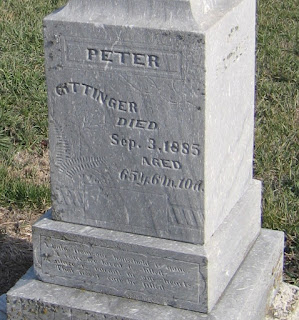Peter, born Feb. 24, 1820, near Baltimore, Maryland, was a son of Francis and Sarah (Byerly) Gittinger (or Gettinger), and the father of Henry Gittinger, longtime editor and publisher of The Chariton Leader.
Although words flowed from Henry Gittinger's pen (later typewriter) like water over Niagara Falls, he was surprisingly reticent about his father, who died of a heart attack at the age of 65 on Sept. 3, 1885, having washed up on the shores of Lucas County some 30 years earlier.
Peter left behind a diary, referred to by Henry as a "log book," detailing his earlier years, however. During 1918, his son rewrote sections of it and published them in five installments in The Leader, so we do know something of his military exploits although the original has vanished.
We know, for example, that when Peter was 18, in the spring of 1838, he enlisted for service in the U.S. Navy and sailed from Annapolis aboard the USS Macedonian (image Wikimedia Commons), a three-masted, 36-gun frigate assigned to protect U.S. interests around the world.
During Peter's first assignment, the Macedonian, assigned to the West Indies Squadron, sailed down the Atlantic coasts of the Americas, around Cape Horn and up to patrol for several months the west coasts of South and North America.
After that, the Macedonian (and Peter) was dispatched to the west coast of Africa to continue its mission of interdicting pirates --- and slave traders --- a mission that continued until 1847.
By 1847, however, Peter had returned to dry land in the United States. We don't know the circumstances. The diary suggests that he was by this time a U.S. Marine attached to the land force of Gen. Stephen Watts Kearny during the Mexican-American War.
Kearny and his Army of the West occupied New Mexico, declaring the territory to be part of the United States on Aug. 15, 1846. From New Mexico, Kearny and his men --- including Peter --- marched to California. And that was how Peter came to be situated in Monterey on the 22nd of March 1847 when he sat down to write a long letter home to his parents in Maryland.
There was, you know, no email back in 1847. That letter, written during March, was postmarked New York during September and would have arrived in Baltimore soon thereafter, after about six months in transit.
I'll have more to say about Peter another time, and plan to transcribe the letter --- but not until I've gotten it situated so that it can be handled without damage. It's survived in remarkably good shape for roughly 175 years and we intend to ensure that it stays that way.




No comments:
Post a Comment